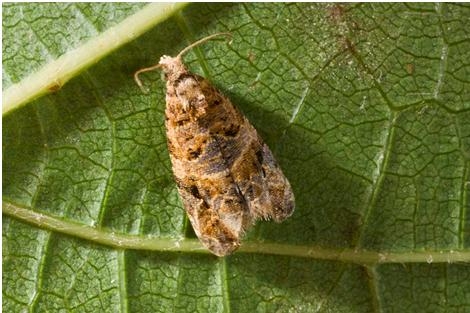European grapevine moth (EGVM), Lobesia botrana, was detected in several Napa County vineyards in the fall of 2009. Native to Mediterranean Europe this invasive insect’s preferred host is grape. Although it is related to other tortricid moths found in vineyards (orange tortrix and omnivorous leafroller) it does not tie leaves together or feed on leaf tissue. EGVM larvae feed on grape flower parts and berries. Late season feeding on berries results in increased incidence of bunch rots.
The adult moth is approximately ¼ inch long with the first pair of wings having a mosaic-pattern (fig.1). Eggs are laid singly which is different than the overlapping egg masses of other vineyard tortricid moths. There are five larval instars. The fully-grown fifth instar is approximately ½ inch (fig. 2). Mature larvae spin a cocoon in which they pupate.
In response to the Napa County finds a statewide trapping program was started in March 2010 to determine if EGVM exists in other grape growing areas of California. The program is a coordinated effort between the county agricultural commissioners, CDFA and USDA. Specific pheromone lures in red “Delta” sticky traps are being used. Early results from the 2010 trapping program has expanded the quarantine area in Napa County and moths have been caught in traps in Sonoma, Solano, Mendocino and Fresno Counties.
Growers wanting to conduct their own trapping programs can purchase the traps and the EGVM specific pheromone lure from commercial vendors.
Additional Information:
UC website: http://www.ipm.ucdavis.edu/EXOTIC/eurograpevinemoth.html
CDFA website:
http://www.cdfa.ca.gov/PHPPS/egvm/index.html

|
Figure 1. Adult female EGVM |

| Figure 2. Earlier stages of EGVM larvae are tan to yellow-brown, while latter stages become dark colored. |